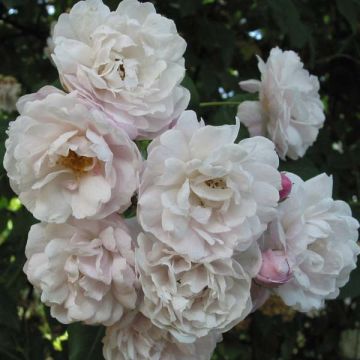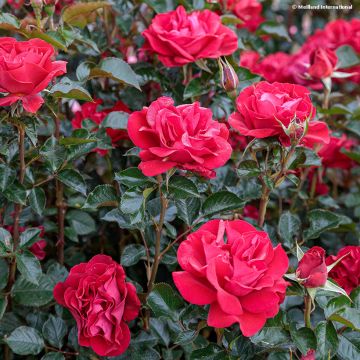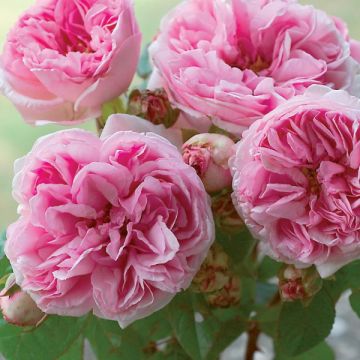

Rosa polyantha Red Ballerina


Rosa polyantha Red Ballerina


Rosa polyantha Red Ballerina
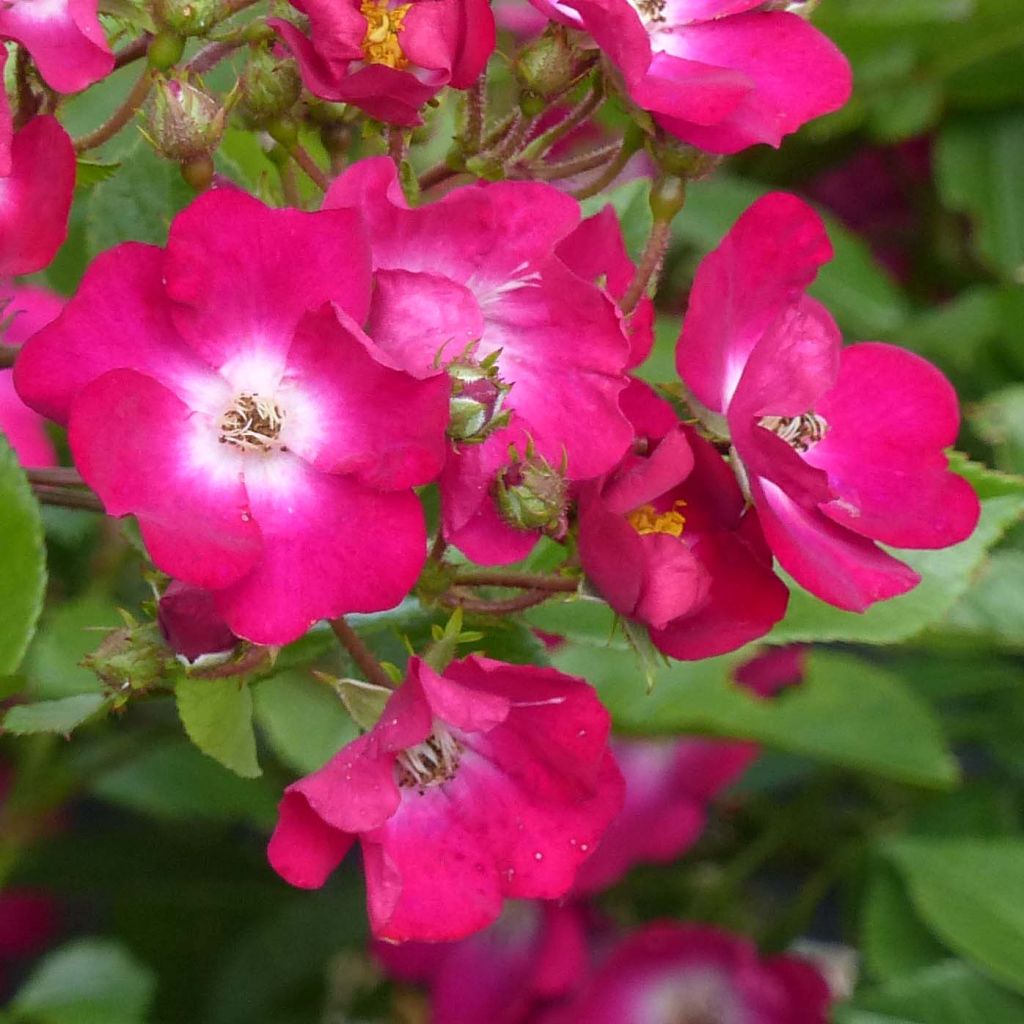

Rosa polyantha Red Ballerina


Rosa polyantha Red Ballerina
Rosa polyantha Red Ballerina
Rosa x polyantha Red Ballerina
Polyantha Rose
This item cannot be shipped to the selected country
Delivery charge from €5.90
Delivery charge from €5.90
Delivery to Corse prohibited
More information
Schedule delivery date,
and select date in basket
This plant carries a 24 months recovery warranty
More information
We guarantee the quality of our plants for a full growing cycle, and will replace at our expense any plant that fails to recover under normal climatic and planting conditions.
From €5.90 for pickup delivery and €6.90 for home delivery
Express home delivery from €8.90.
From €5.90 for pickup delivery and €6.90 for home delivery
Express home delivery from €8.90.
Delivery to Corse prohibited: UE law prohibits the import of this plant from mainland France to Corse as part of the fight against Xylella fastidiosa. Please accept our sincere apologies.
More information

Does this plant fit my garden?
Set up your Plantfit profile →
Description
The Red Ballerina Rose bush, a variety with flowers of a deeper pink than the famous Ballerina, resembles a hydrangea in full bloom, with its small carmine wild roses tightly packed into large clusters, each with a small white heart. They bloom from June to October on a sturdy, vigorous bush, bursting with health. The colour of its flowers, fresh and cheerful but not aggressive, is easy to match with other white, pink, purple, or even violet roses. This variety is easy to grow in any well-prepared soil and it will thrive everywhere, even at high altitude.
The Rosa (x) polyantha Red Ballerina rose is not strictly an old rose, as it was created by Harkness in 1974. Nevertheless, it has all the characteristics of an old rose, except for the fragrance, which is absent from its flowers. Its ancestry hails from musk roses (Rosa moschata) and, of course, polyantha roses. This variety forms a bush with a sturdy, dense, upright habit, reaching a height and width of about 1.2m (4ft), sometimes more depending on growing conditions. Its flowering is very long and continuous, from June-July to October-November. Its single, bicoloured flowers, 2-3cm (0.8 - 1.2in) wide, consist of 5 regular petals arranged in an open cup, revealing a golden yellow stamen centre. The dominant colour is a very bright carmine pink, surrounding a small central white area. The flowers are tightly packed in generous clusters that appear at the tips of the current year's shoots. If left undisturbed, it forms attractive orange hips. The deciduous foliage is small and slender. Its colour is a pure, glossy light green, and is highly disease resistant.
The Red Ballerina Rose adapts to all soils that are not too dry and all climates, even at higher altitudes. Planted in mass, it will border the pathways and underscore the shrub borders. It will blend perfectly with a medium landscape hedge, where it will enhance the foliage of dogwoods and viburnums. It can also be combined with pretty, easy-to-grow perennials such as perennial geraniums (Geranium Blue Cloud, Anne Folkard, Nimbus, Orion), bellflowers (lactiflora, rapunculoides), catmints, snapdragons, bear's breeches, foxgloves...
If you have enough space, English, Old, or Shrub Roses are magnificent when planted in groups of three. They will grow together to form a single, opulent bush that will flower even more generously.
Report an error about the product description
Rosa polyantha Red Ballerina in pictures


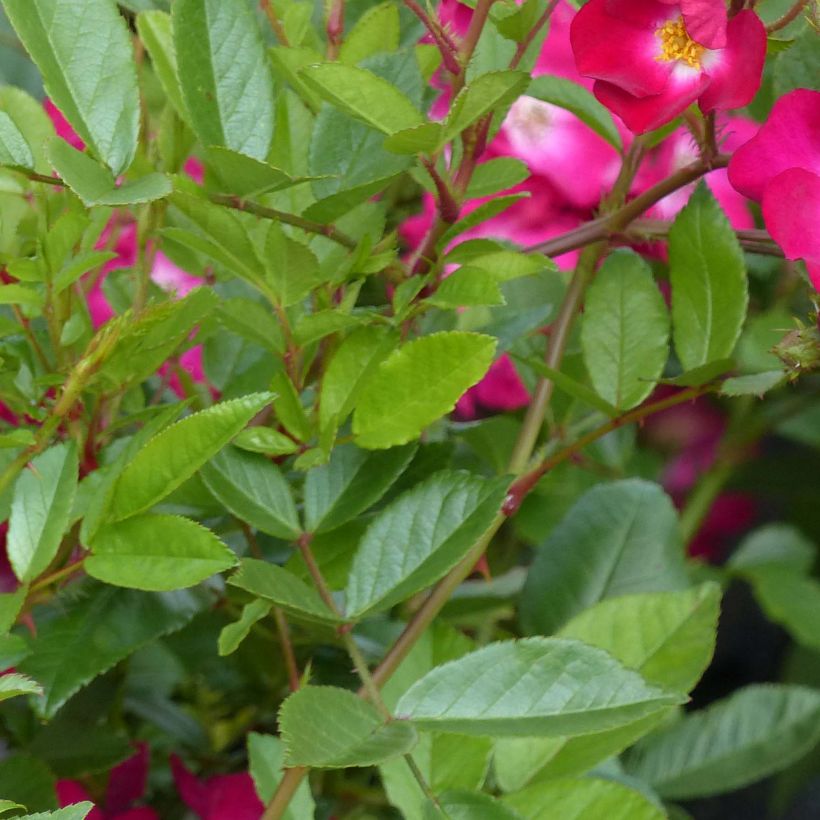

Plant habit
Flowering
Foliage
Botanical data
Rosa
x polyantha
Red Ballerina
Rosaceae
Polyantha Rose
Cultivar or hybrid
Rosa canina Laxa (4L/5L pot, Wrapped bare root)
Other Traditional Roses
Planting and care
Plant your red Ballerina Rose in a sunny or lightly shaded position. Old roses are tolerant but do not appreciate excess limestone and overly dry soils. They will adapt to any garden as long as the soil is well worked, not too heavy, and sufficiently rich. To plant your rose, work the soil and add blood, fish and bone to the bottom of the planting hole. Water thoroughly after planting to remove any air pockets. Water regularly for a few weeks to encourage rooting.
Pruning old roses mainly involves removing faded flowers as they appear, unless you want to keep the decorative hips
Avoid pruning to maintain an interesting bushy shape.
However, in late winter (March), remove branches located in the middle of the bush as this can lead to overcrowding.
Planting period
Intended location
Care
-
, onOrder confirmed
Reply from on Promesse de fleurs
Haven't found what you were looking for?
Hardiness is the lowest winter temperature a plant can endure without suffering serious damage or even dying. However, hardiness is affected by location (a sheltered area, such as a patio), protection (winter cover) and soil type (hardiness is improved by well-drained soil).

Photo Sharing Terms & Conditions
In order to encourage gardeners to interact and share their experiences, Promesse de fleurs offers various media enabling content to be uploaded onto its Site - in particular via the ‘Photo sharing’ module.
The User agrees to refrain from:
- Posting any content that is illegal, prejudicial, insulting, racist, inciteful to hatred, revisionist, contrary to public decency, that infringes on privacy or on the privacy rights of third parties, in particular the publicity rights of persons and goods, intellectual property rights, or the right to privacy.
- Submitting content on behalf of a third party;
- Impersonate the identity of a third party and/or publish any personal information about a third party;
In general, the User undertakes to refrain from any unethical behaviour.
All Content (in particular text, comments, files, images, photos, videos, creative works, etc.), which may be subject to property or intellectual property rights, image or other private rights, shall remain the property of the User, subject to the limited rights granted by the terms of the licence granted by Promesse de fleurs as stated below. Users are at liberty to publish or not to publish such Content on the Site, notably via the ‘Photo Sharing’ facility, and accept that this Content shall be made public and freely accessible, notably on the Internet.
Users further acknowledge, undertake to have ,and guarantee that they hold all necessary rights and permissions to publish such material on the Site, in particular with regard to the legislation in force pertaining to any privacy, property, intellectual property, image, or contractual rights, or rights of any other nature. By publishing such Content on the Site, Users acknowledge accepting full liability as publishers of the Content within the meaning of the law, and grant Promesse de fleurs, free of charge, an inclusive, worldwide licence for the said Content for the entire duration of its publication, including all reproduction, representation, up/downloading, displaying, performing, transmission, and storage rights.
Users also grant permission for their name to be linked to the Content and accept that this link may not always be made available.
By engaging in posting material, Users consent to their Content becoming automatically accessible on the Internet, in particular on other sites and/or blogs and/or web pages of the Promesse de fleurs site, including in particular social pages and the Promesse de fleurs catalogue.
Users may secure the removal of entrusted content free of charge by issuing a simple request via our contact form.
The flowering period indicated on our website applies to countries and regions located in USDA zone 8 (France, the United Kingdom, Ireland, the Netherlands, etc.)
It will vary according to where you live:
- In zones 9 to 10 (Italy, Spain, Greece, etc.), flowering will occur about 2 to 4 weeks earlier.
- In zones 6 to 7 (Germany, Poland, Slovenia, and lower mountainous regions), flowering will be delayed by 2 to 3 weeks.
- In zone 5 (Central Europe, Scandinavia), blooming will be delayed by 3 to 5 weeks.
In temperate climates, pruning of spring-flowering shrubs (forsythia, spireas, etc.) should be done just after flowering.
Pruning of summer-flowering shrubs (Indian Lilac, Perovskia, etc.) can be done in winter or spring.
In cold regions as well as with frost-sensitive plants, avoid pruning too early when severe frosts may still occur.
The planting period indicated on our website applies to countries and regions located in USDA zone 8 (France, United Kingdom, Ireland, Netherlands).
It will vary according to where you live:
- In Mediterranean zones (Marseille, Madrid, Milan, etc.), autumn and winter are the best planting periods.
- In continental zones (Strasbourg, Munich, Vienna, etc.), delay planting by 2 to 3 weeks in spring and bring it forward by 2 to 4 weeks in autumn.
- In mountainous regions (the Alps, Pyrenees, Carpathians, etc.), it is best to plant in late spring (May-June) or late summer (August-September).
The harvesting period indicated on our website applies to countries and regions in USDA zone 8 (France, England, Ireland, the Netherlands).
In colder areas (Scandinavia, Poland, Austria...) fruit and vegetable harvests are likely to be delayed by 3-4 weeks.
In warmer areas (Italy, Spain, Greece, etc.), harvesting will probably take place earlier, depending on weather conditions.
The sowing periods indicated on our website apply to countries and regions within USDA Zone 8 (France, UK, Ireland, Netherlands).
In colder areas (Scandinavia, Poland, Austria...), delay any outdoor sowing by 3-4 weeks, or sow under glass.
In warmer climes (Italy, Spain, Greece, etc.), bring outdoor sowing forward by a few weeks.

































